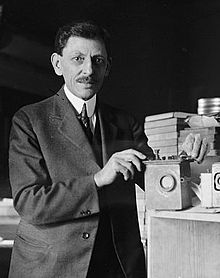Paul Bartsch (zoologist)
Paul Bartsch (born August 14, 1871 in Tuntschendorf , Neurode district , province of Silesia ; † April 24, 1960 in McLean , Virginia ) was an American zoologist of German origin who was best known as a malacologist and ornithologist .
Life
At the age of ten, Paul Bartsch emigrated with his family to the USA and settled first in Missouri and later in Iowa . Bartsch began to be interested in ornithology at an early age . He studied at Iowa State University , where he earned a Bachelor of Sciences in 1896 , a Master of Science in 1899 and a doctorate in 1905.
From 1907 to 1908 Bartsch took part in the expedition to the Philippines as a scientist for the Smithsonian Institution on board the Albatross . He later directed research on the hatching of snail eggs in the Florida Keys for the Smithsonian Institution and Carnegie Institution of Washington .
In 1912 Bartsch began a series of investigations that lasted until 1933 and aimed at exploring the Gulf of California , the Bahamas , western Mexico , Florida , Cuba , Haiti , Santo Domingo , Puerto Rico , all of the West Indies between Puerto Rico and Trinidad and the Gulf of Saint Lawrence contributed.
In Washington, DC , Bartsch taught natural history at Howard University from 1899 to 1936 and zoology at George Washington University from 1900 to 1945 . From this he was also awarded an honorary doctorate in 1937 . Bartsch retired in 1946.
At the same time, he was in charge of the department for molluscs at the National Museum of Natural History from 1914 to 1946 as curator . He attended the Second Pan American Science Congress in Washington, DC in 1916 as a deputy from the Smithsonian Institution and in 1920 as a deputy to the first Pan Pacific Science Congress in Honolulu , Hawaii . In 1920 he made a poison gas detector available to the United States Army's Chemical Warfare Service . Bartsch led the Johnson-Smithsonian deep-sea expedition to Puerto Rico in 1933 and the Smithsonian-Roebling research expedition in 1937. He was the first scientist after John James Audubon to study bird ringing.
He was a Fellow of the American Association for the Advancement of Science and a member of the Washington Academy of Sciences , the Biological Society of Washington , the American Ornithologists' Union , the American Association of Anatomists , the American Society of Zoologists , the American Genetic Association , the Malacologists Association of Great Britain and Ireland , American Malacological Society and by Sigma Xi . In 1913 he was accepted into the Washington Biologists' Field Club and made an honorary member in 1949.
After retiring into private life due to old age, Bartsch devoted himself to his collection of native plants on his estate near Pohick , Virginia . After his death, he was buried in Washington, DC.
Publications (excerpt)
- Paul Bartsch: Experiments in the Breeding of Cerions , Carnegie Institution of Washington, 1920
- John Treadwell Nichols , Paul Bartsch: Fishes and Shells of the Pacific World , The Macmillan Company, 1945
Individual evidence
| personal data | |
|---|---|
| SURNAME | Bartsch, Paul |
| BRIEF DESCRIPTION | American zoologist |
| DATE OF BIRTH | August 14, 1871 |
| PLACE OF BIRTH | Tuntschendorf , District of Neurode , Province of Silesia |
| DATE OF DEATH | April 24, 1960 |
| Place of death | McLean , Virginia |

